Outside of their standard annual leave entitlement, there may be times when your employees are unable to be at work. This includes unexpected short-term illnesses, recuperation after an operation or a longer period of ill health.
It’s important that you implement and maintain a fully-comprehensive sickness policy in your workplace. It protects your business, HR team and employees themselves.
In this guide, we’ll explore:
- The benefits of a sickness policy
- Why a sickness policy is important for businesses
- Reasons for absence
- How to implement a sickness absence policy
What is a sickness policy?
A sickness policy sets out a fair framework for how your business deals with illness-related absences. It should contain a list of actions that your employees must follow to accurately report their absences and keep the business up to date on their expected return.
Having a sickness policy in place gives both your HR team and your employees a clear framework on how to handle absences. It creates a fair, undisputable course of action if an employee is too unwell to carry out their usual duties.
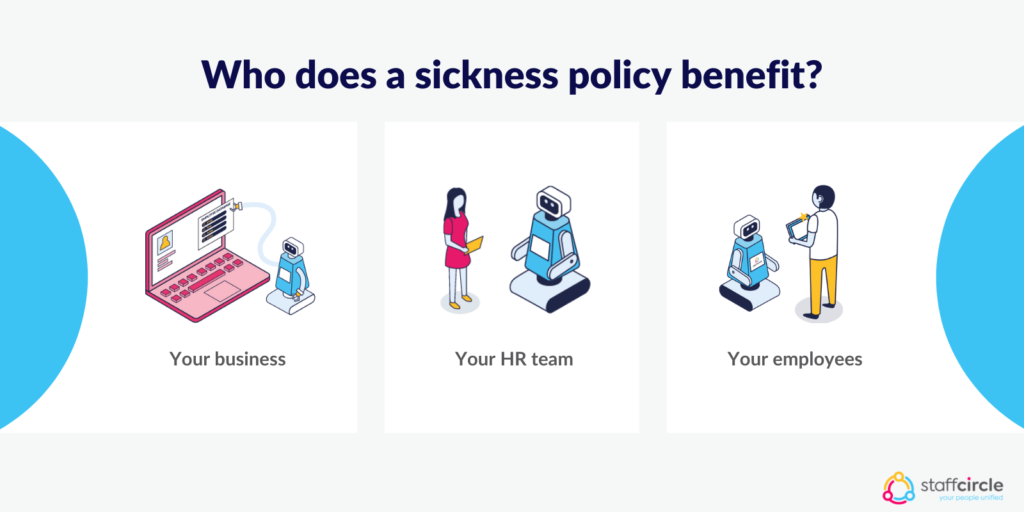
How a sickness policy benefits your business
If you don’t have a defined absence policy in place, your employees don’t know where they stand. If it’s something that’s never mentioned, they may be wary of taking any sick days at all, leading to possible workplace incidents or burnout.
Alternatively, if employees are not given guidance around what you constitute acceptable as a sick day, they may take them more than necessary. Frequent and unexpected sick days can disrupt a department’s productivity and negatively affect other members of staff.
When your workers are required to adhere to a strict policy on reporting an absence, action can be taken to minimise disruption as soon as possible. It allows business to flow more smoothly and keep on top of goals.
Ultimately, the goal of an effective sickness policy is to maximise your business’ efficiency whilst maintaining the safety of employees. The ability to be open about illnesses and receive understanding and support leads to a happier, more engaged workforce.
How a sickness policy benefits your HR team
A comprehensive sickness policy enables your wider HR team to carry out their duties efficiently and without doubt. If you’re in HR, you know how important it is to avoid employee bias. Implementing a policy which accounts for a wide range of potential absences removes this obstacle.
Guidelines which detail every step of the process set out a clear framework that HR teams can implement business-wide. It can help to limit the possibility of any liabilities or discrimination in the workplace. An extensive absence policy leaves little room for doubt, meaning that your HR teams can give advice efficiently.
Whether they’re faced with questions from employees or need to help managers address an illness on their team, they can refer to standard practice to minimise admin work.
How a sickness policy benefits your employees
Understanding exactly what the business you work for classes as an absence makes life a lot easier. A readily available policy that employees can reference will lead to fewer HR queries and reassured workers.
Full requirements on what to do when unwell can also keep workers safer. Rather than continuing to work when unwell, a proper reporting process that leads to managerial action can help to stop illnesses from getting worse.
If your employees understand exactly what is required of them, and how any absences affect the wider team, they are more likely to be engaged and responsive. Everyone gets sick from time to time, so knowing that they are fully supported can give a boost to workplace morale.
Why is it important to have a sickness policy in place?
A comprehensive sickness or absence policy is essential when running your business. It is a universal framework that all employees adhere to, removing any doubt or disparity in your HR team’s response to illness.
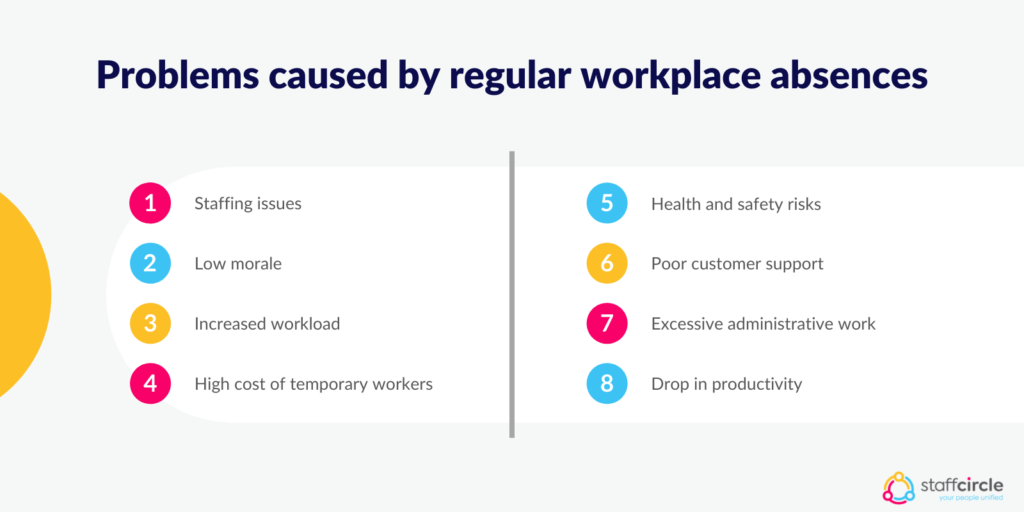
Regular absences in the workplace can cause a wide range of problems. These can impact the employee experience, customer satisfaction and project delays. Some of the main negatives include:
- Staffing issues
Whether your team works regular office hours, on a rota or on shifts, absences can cause problems with staffing levels. If you require a certain number of employees on-site to carry out business operations safely, any absences can affect work speed, quality and safety. - Low morale
Teams are negatively affected by the regular absence of other employees. They may have to pick up the slack, explain delays in production or take on work which they’re not fully briefed on. Feeling unsure of the work they’re doing will impact their morale and job satisfaction. - Increased workload
In many businesses, whenever there’s an absence someone else has to pick up the extra work. If this is a regular occurrence, the employees doing extra work could be at risk of burnout. This can affect all areas of their job performance and ultimately impact your bottom line. - High cost of temporary workers
If an existing staff member can’t cover an absent employee, hiring a temporary employee to take their place maybe your best option. However, this can become costly. Sick pay for your absent employee, coupled with agency fees and money spent on training their replacement means a sizeable increase in budget. - Health and safety risks
Your employees are trained to carry out their role and its requirements. When they are absent, colleagues who may not be subject matter experts often step in. However, they may not have the knowledge or skills to know what to do if something goes wrong. - Poor customer support
Gaps in your staff levels can affect your customers directly, too. Absences can cause increased response times, delays in shipping, or messages getting missed during absences. This can lead to a negative customer experience and reduced future sales. - Excessive administrative work
High levels of absence in the workplace creates extra administrative tasks for your employees, managers and HR teams. Filling in sick notes, organising emergency cover and adjusting payroll add a large amount of work and increased time for all your employees. - Productivity
No matter what business you’re in, it’s important that you’re working towards goals. Whether it’s a new product launch or reaching new sales goals, projects of all sizes are affected by absent employees. High levels of colleagues unable to work mean drops in productivity and delays to your overarching company goals.
Reasons for absence
When it comes to sickness absence, there are a whole host of reasons that an employee could be unable to work. Employees can be affected differently by what would appear to be the same illness. This means that it’s important to allow a broad range of outcomes in your sickness policy.
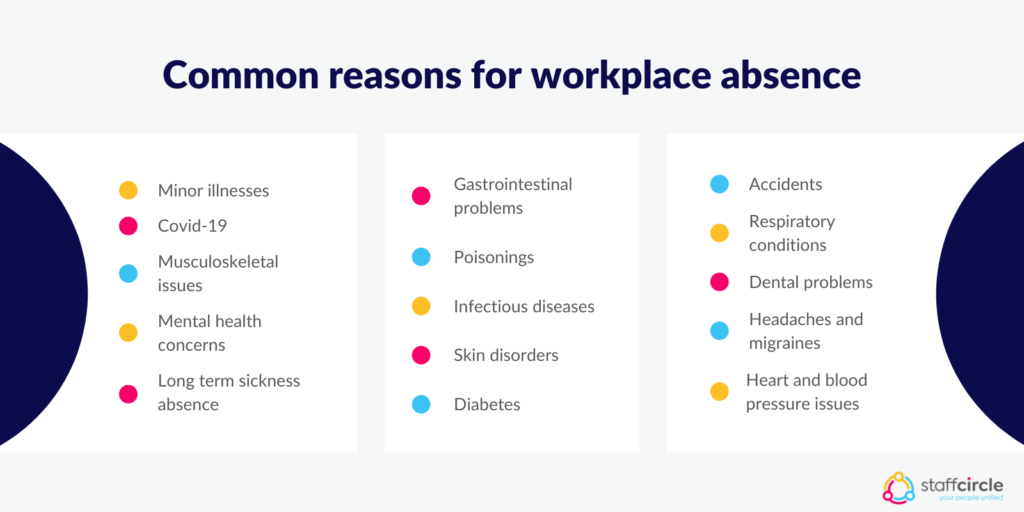
The majority of causes fall into one of the categories below:
Minor illnesses
The most common causes of unexpected sick leave are minor illnesses. This category accounted for more than a quarter of all absences reported in the UK in 2020, according to the Office of National Statistics.
These are classed as your typical ailments that require just a few days off work. This can include the common cold, flu or vomiting bugs. While they often don’t require a long time off work, they can be highly contagious and spread around an office quickly.
This can be more disruptive to businesses than long-term or planned absences. A repeated need to find emergency cover for multiple members of a team can cause issues with staffing and productivity.
Covid-19
Many businesses have had to drastically evolve their existing sickness policy since the onset of the pandemic.
In the past, a traditional workplace environment often led to employees ‘working through’ minor illnesses such as the common cold. However, the government policy of staying at home when testing positive, no matter whether symptomatic or asymptomatic, made this impossible.
This led to widespread staffing and logistical headaches for HR leaders. Without a more flexible sickness policy, they would struggle to carry out vital business operations.
More comprehensive sickness policies were introduced nationwide, to account for all new eventualities.
Musculoskeletal issues
Outside of short-term illnesses and Covid-19, musculoskeletal problems are the third most reported cause of sick leave.
The term musculoskeletal covers any problems relating to bones, muscles, tendons ligaments and soft tissue. Therefore, common complaints about this type of absence include neck, back and limb pains.
This can affect all types of businesses, particularly those that include manual labour. These pains can often take weeks or months to recover from, leaving busy teams short-staffed.
Musculoskeletal problems can affect office workers too, with poor posture a common cause of back pain. Occupational health checks should be taken on board at all sites to prevent issues like this from happening.

Mental health concerns
No matter the role, seniority or industry, many workers in the UK carry out their role whilst living with a mental health diagnosis.
Although the full spectrum of diagnoses is endless, sickness policies can be split into a few categories. This includes long-term conditions and shorter, unexpected mental health issues.
Employee burnout and stress is a huge cause of sick leave in businesses. Those who are overworked or face problems in the workplace can become unable to perform their role. This can require a temporary leave of absence from work, which would fall under a sickness policy.
Many individuals who live with pre-existing mental health conditions don’t require frequent time off work. However, it’s a possibility that their mental health will affect their ability to perform their role from time to time.
Long term sickness absence
In the UK, long term sickness absences are classed as those which require more than four weeks off work. This can include anything from a prolonged illness to an injury which requires substantial recovery time.
Depending on your company’s individual absence policy, employees on long term sick leave may have their pay altered. Some companies offer a benefit of fully-paid sick leave, but this can be heavily caveated and HR teams must be careful to understand whether employees qualify.
Other absences
The above categories are far from comprehensive, as there are a huge amount of reasons why an employee could require sick leave. Depending on the individual, the severity of the sickness could vary and result in a widely different absence leave requirement.
Other common absence causes listed in the ONS report referenced above are:
- Accidents
- Poisonings
- Infectious diseases
- Skin disorders
- Diabetes
- Gastrointestinal problems
- Respiratory conditions
- Dental problems
- Headaches and migraines
- Heart and blood pressure issues
Implementing a sickness absence procedure
When implementing or updating your company’s sickness policy, there are a whole host of topics to consider. We’ve covered the main points below, and given some actionable examples of content you can refer to:
How to define an absence
It’s important to outline your policy with a clear, concise guide on what you are prepared to accept as an absence. Include this right at the beginning of the document, in easy-to-understand language, that leaves little room for doubt.
If necessary, include a breakdown of the different types of absences and give brief details. A good example of how to structure this is:
- Short-term unexpected absences
- Includes minor illnesses such as the common cold or a vomiting bug
- Will require anything from one day to a week away from the office
- Covid-19
- If you test positive for Covid-19
- Depending on government guidelines and current office policies, may require self-isolation for a period of days
- Musculoskeletal issues
- Including back pain, neck pain and other injuries
- Will require a period of recovery time before manual labour can be undertaken again. May require adaptations to daily tasks.
- Mental health concerns
- Includes time away from the office for pre-existing or new mental health diagnosis
- Recovery time will vary on a case-by-case basis
- Long-term health concerns
- Includes prolonged illnesses or injuries with a recovery period
- Classed as anything over four weeks of absence
Understanding how you classify absences makes the process easier for your employees to follow. This is a document that they will receive when starting employment with your company, so it’s best to be upfront and honest straight away.
How to report an absence
Communicate the exact process that your employees must follow when reporting an absence. Usually, they would first raise this with their direct manager, who can then escalate and raise it with HR.
However, with different types of absence come different ways to report. Putting these reporting actions into context for your employees is a great way to make the process easier to understand:
- Short-term illnesses and Covid-19
- If you are unexpectedly unable to work, you must notify your manager before you are due to start that day
- Although it can be difficult to put a timeframe in mind, try to estimate how many days off you will need
- Your manager will take action to cover your duties while you’re away from work
- They will notify HR, who can prepare any office-related documentation
- Musculoskeletal injuries and long-term sick leave
- If you are experiencing pain or an illness that leaves you unable to carry out your normal duties, let your manager know as soon as possible
If you report any minor issues immediately, action can be taken to adapt your role and prevent a possible leave of absence - Your manager will liaise with HR and your Occupational Health representative. They will involve you in determining the best course of action. This could include either absence leave or an adapted working environment
- You will most likely be required to visit a medical professional to receive an evaluation and plan of recovery
- If you are experiencing pain or an illness that leaves you unable to carry out your normal duties, let your manager know as soon as possible
- Mental health concerns
- If you have any concerns about your mental health or are unable to carry out your regular duties, please speak with your line manager or the HR team as soon as possible
- You will be involved in the process of determining the best course of action. Support will be provided by the most appropriate figure.
As you can see, there are several different reporting methods available. To create a healthy and open culture, you must be understanding of any reports of ill-health in the workplace.
Reporting a short-term illness is the most common use of this policy. This means you should take great care to create a system that works best for your individual business. That could mean requiring employees must report an illness a certain amount of time before their shift starts.
It can also affect who employees need to contact to report an absence. For example, if an employee does not always work the same hours as their direct manager, it could be more appropriate for them to report their illness directly to HR.
Providing appropriate support for employees with absences
As an employer, you want to reassure your employees that you have their best interests at heart. After all, a happy and healthy workforce results in a more productive work environment!
How you support absence will therefore need to be assessed on a case by case basis. It’s a good idea to lay out a framework of the full support system that your employees can access in times of ill health.
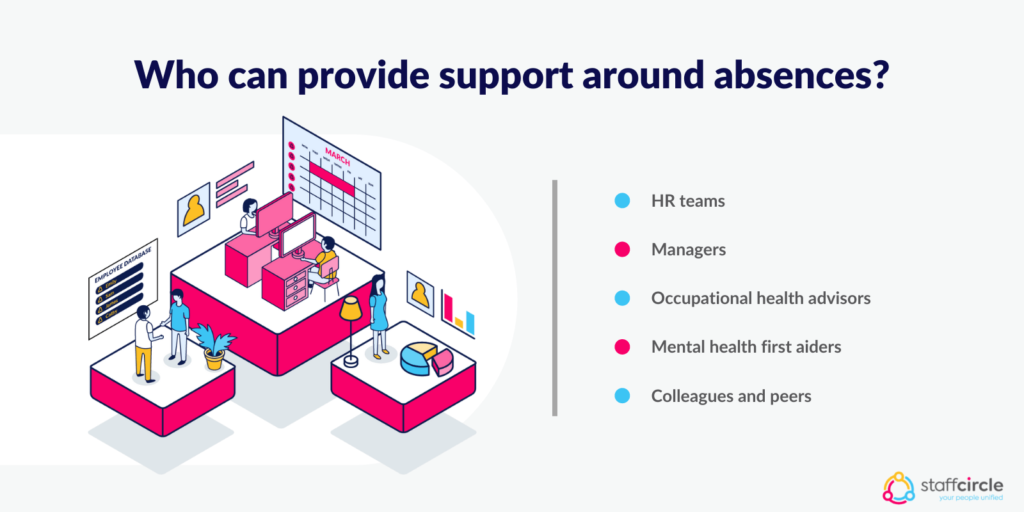
A great way to structure this support system and how each category functions is outlined below:
- HR team
Provide support and guidance to all employees around sick leave. HR teams oversee every reported absence, so can advise affected employees and their managers. If an employee feels uncomfortable discussing an absence with their line manager, Human Resources can help. They can book a meeting or drop in to discuss any concerns in a confidential environment. - Managers
For a large number of reportable illnesses, the employee’s direct manager should be their first port of call. Whether they’re unable to attend work that day or have an upcoming operation scheduled, managers are there to help respond and plan. - Occupational health advisor
This is someone who works impartially to enable employees to perform to the best of their abilities. If an employee needs adaptations as a result of ill health, occupational health advisors can help devise a plan of action. - Mental health first aiders
If your business hasn’t already implemented this scheme, it’s a great addition to a health and safety program. Simply put, mental health first aiders are nominated members of your team who are trained to offer peer-to-peer mental health and safety support. There are many popular professional development courses available to develop interested members of your team. - Colleagues and peers
In an ideal world, all your employees would be engaged and working as a team to achieve your company goals. As part of this, they should be open and understanding to anyone suffering from a period of ill-health. It’s important to help foster this sense of support in all areas of your business to create a healthy and motivated team.
Recording sickness absence
It’s important to record every instance of sickness absence. This allows your HR team access to data to see the most common causes of absence and when they happen. It can also help them to identify any employees who have an ongoing issue with frequent absences.
Using dedicated absence management software is the easiest way to achieve this. It allows your employees to track and monitor absence in one simple portal. Managers can submit absences and notify HR teams immediately. This can then automatically tie into an overall view of each employee’s performance.
How you measure absence levels
It’s possible to measure levels of absence in different ways. It’s important to do so to ensure that your workforce is operating at full capacity. As mentioned above, there is a measurable cost associated with frequently absent employees.
A popular way to measure absence levels is by using the Bradford Factor. The Bradford Factor calculates the instances of absence each employee records over a set period of time. It then combines this with the total number of days absent over that same period.
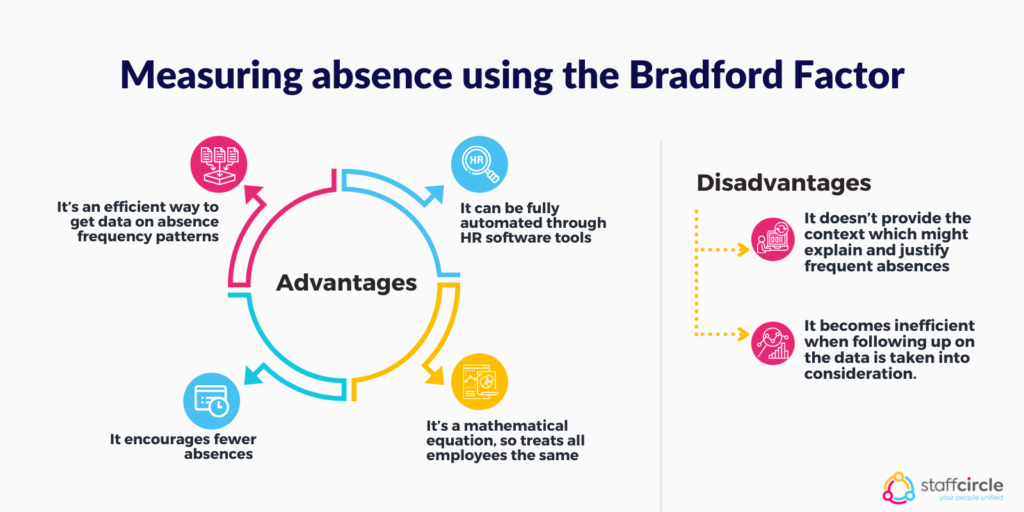
This calculation can be done automatically by your dedicated HR operations solution. Employees who score a higher number on the Bradford Factor are those who take frequent short periods of absence from the workplace.
Identifying employees who frequently record these shorter periods of absence allows you to take action early and implement processes to improve their attendance. It enables you to understand exactly what’s happening, and how you can maximise their productivity.
What happens if an employee has unacceptable levels of absence
The amount of absence that your business is prepared to accept will vary from industry to industry. It can also differ based on the type of role or contract an employee is working on.
Thought must be given to the types of absence that an employee has. If they are frequently absent unexpectedly, this may be looked at differently than one longer sickness period.
Build some ‘trigger points’ into your sickness policy. Either use the total number of absences, frequency of absences or a certain Bradford Factor score. This gives your employees a definite reference point as to what constitutes unacceptable levels of absence.
From there, you can tie this in with your existing disciplinary procedure. This could include different stages of disciplinary measures, with a chance to redeem actions based on a specified time period.
How an employee can prove absence requirements
As part of your absence policy, you may require employees to provide proof of ill health. For your employees, the most common way of doing this is providing a sick note on return to work.
The type of proof you can request depends on the severity of the illness:
- Short-term illnesses
The government’s policy on absences states that employees are not required to provide any medical documentation as proof for illnesses of seven days or less. As a business, you can choose to document the reason behind their illness. You can implement a ‘self-certification’ process, whereby employees send details of their illness via a form, letter or email. - Long-term illnesses, musculoskeletal injuries and mental health concerns
If an employee is on sick leave for more than seven days, they must provide proof of their health status from their doctor. This is called a ‘fit note’ and is free for them to request from their GP practice. It proves that they are taking sick leave for a legitimate reason. It can also include recommendations for how to adapt their role on return to work and possible timescales for required absence. - Covid-19
Covid-19 has been a leading cause of absence since the beginning of 2020. A specific self-certification form called an ‘isolation note’ was created to help businesses document coronavirus-related absences.
What happens when an employee returns to work
When your employee wants to resume working after sick leave, they should let you know their expected date of return. It allows you to prepare for their first day back, and update any relevant internal procedures that have been applied since they were last working.
As an employee-focused business, make sure to make them feel welcome and appreciated. After all, you hired them for their individual skills, and it’s key to helping them make the transition back into working life.
A simple greeting of “it’s great to see you again!” is a good ice breaker. If they are feeling anxious about their return, a warm welcome will help ease any nerves and help them get settled back in. Encourage their manager to make sure they are included in team conversations during their first week to ease the transition.
The length of time that your employee is absent determines how you need to respond when they return to the office:
- Short-term illnesses
It’s important to make sure that the employee is fit enough to resume their duties. If they have been off with a contagious illness, make sure that they aren’t at risk of passing the illness on to the rest of your team. Ask their manager to carry out a short one2one check-in with them. This can be used to make sure they are okay, to update them on how their role was covered and inform them of any outstanding tasks. - Long-term illnesses
An employee returning to work after a prolonged period of sick leave will need a more in-depth one2one. Ideally, they should initially meet with both HR and their manager, as there may have been significant changes since they were gone. Explain how their role has been covered, any relevant personnel changes, and clarify the aims and objectives of their role.
Statutory Sick Pay
In the UK, many businesses offer Statutory Sick Pay for employees who are on long term sick leave. This is an amount of money, the total set by the government, that they will be paid by your business while they’re unable to work.
Employees are entitled to receive Statutory Sick Pay for up to 28 weeks. This is to help them cover costs while they aren’t working. It is up to your business to pay these costs, alongside the costs of any temporary workers you hire to replace them.
According to government guidelines, to qualify for Statutory Sick Pay, an individual must have an employment contract with your business. They need to earn an average of at least £123 per week and have been unwell for at least four days in a row (including non-working days).
Occupational sick pay
Your business may choose to offer occupational sick pay as an employment benefit. This is totally optional and is often a benefit associated with high candidate competition.
If your business chooses to offer occupational sick pay, your employees will not receive Statutory Sick Pay. Instead, they will receive a higher amount, decided on by each individual company.
This often consists of an extended period of full pay as occupational sick pay, often for a month or six weeks. This is then followed by Statutory Sick Pay further down the line.
Resources to reference for further advice
If you’re looking to implement a sickness and absence policy, check out these helpful UK government guides and resources for further information:





